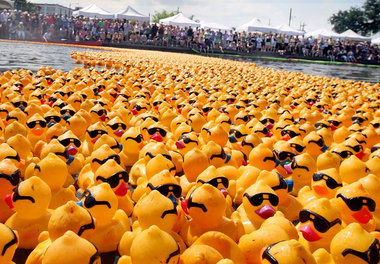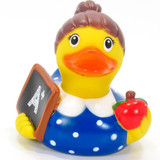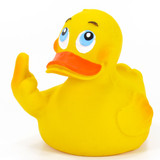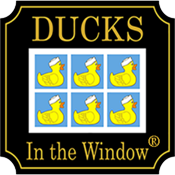Yes we know, who would ever believe that there are so many rubber ducks styles to choose from and that it would warrant a section on our website to explain all about rubber ducks. The following should provide you everything you every wanted to know or needed to know about where rubber ducks come from, how they are made, and what they are made from.
Material
Even though we call them "rubber" ducks, the majority of products on the market today are made from a synthetic vinyl polymer plastic. A process call vulcanization determines the level of malleability or how soft and flexible a plastic wii be.
We carry a brand called Lanco from Spain that is the oldest company manufacturing true "rubber" ducks from the sap from a rubber tree. They have been manufacturing 100% all natural toys for pets and infants since 1951.
Manufacturing Process
Most people don't realize the level of work and effort that goes into each and every rubber duck creation. The process is essentially the same from the early 50's when the rubber duck was first made for mass production. The manufacturing process can be simple broken down into 5 phases:
- Creative design composition from sketch approval or more modern 3D digital design representation
- The approved design is then made into a clay sculpture
- Molds are made from the original sculpture
- Plastic is poured into the molds and a centrifuge spins the plastic creating a hollow product with a hole on the bottom
- Most ducks are hand painted with stencils and why they are so labor intensive
Shapes & Sizes
Rubber ducks can be found in all shapes and sizes, but essentially there are 4 different types of rubber ducks ranging from Jumbo, Medium, Small, and what we define as premium collector quality rubber ducks.
- Jumbo sizes are about 9"-11" and are less malleable and more stiff to support the size and shape of the rubber duck.
- Medium ducks are the most common, about 3" that can fit in the palm of your hand. This size are most common among bath toys and made popular by Sesame Streets Ernie character who played with his ducky in his tubby. You will find the largest selection of custom designs in a medium duck, which makes them fun to collect or give as gifts that can match most any age or personalty.
- Small rubber ducks are typically novelty items that are the poorest quality and typically found as give aways at carnivals and vending machines. They tend to lack the detail or quality in finish work found with other rubber ducks.
- Premium rubber ducks are highly collectable and come in unique packaging that makes them more a unique gift. A higher level of craftsmanship goes into the manufacturing process, which can bee seen in the level of detailing and paint quality. Tubbz brand is the only company that has officially licensed characters and the detail work is accomplished by newer injected molding technology.
Rubber Duck History
Rubber duck toys first appeared in the late 1800s, when manufacturers made use of Charles Goodyear’s vulcanization process for rendering rubber into malleable material. The first rubber ducks didn’t even float: they were cast solid and intended as chew toys. In the 1940's Sculptor Peter Ganine created a sculpture of a duck, then patented it and reproduced it as a floating toy, of which over 50,000,000 were sold. These ducks developed into the iconic floating yellow figure with bright orange bill we recognize today. Nothing is more Americana than the rubber duck founded and created in the USA!
For many decades, most duck figures have been made of vinyl, but we still call them rubber ducks. Rubber ducks naturally inspire water play that develops muscle strength and coordination. With their bright color, smooth texture, and (for some) squeaky or quacky sounds, rubber ducks sharpen toddlers’ senses. Their presence in the bathtub soothes youngsters’ fears of water and water immersion and makes good clean fun of the routine hygiene they’re learning.
Rubber ducks have been recognized as the quintessential bathtub toy since 1970 when Ernie, the cheerful orange Muppet on Sesame Street, first sang the catchy song “Rubber Duckie You're The One” to his best bath time buddy. The song rose to number 16 on Billboard’s chart of hit tunes and, decades later, kids still sing the praises of their water play pals. Check out the video below.
Adults, too, appreciate rubber ducks. Collectors proudly display variations of the classic form that proclaim their affinity to colleges, careers, sports, celebrities, and holidays. Aficionados adorn their homes with rubber duck–themed shower curtains, towels, bathrobes, nightlights, and wallpaper. “Rubber Duckie, you’re the one,” indeed!
Rubber ducks are collected by a number of enthusiasts from all over the world. The Guinness Book of World Records for the World's Largest Rubber Duck Collection stands at 5,632 different rubber ducks, and was awarded to Charlotte Lee. Famous people that are known to collect rubber ducks include Zooey Deschanel, Liam Neeson and David Bowie.

Rubber duck races, also known as derby duck races, have been used as a method of fundraising for organizations worldwide. People donate money to the organization by sponsoring a duck. At the end of the fundraising drive, all of the ducks are dumped into a waterway, with the first to float past the finish line winning a prize for sponsors and charities.
There are thousands of races held each year in the USA and internationally. The largest race in the United States is the annual Freestore Foodbank Rubber Duck Regatta in Cincinnati, Ohio. First run in 1994, the Rubber Duck Regatta now features over 100,000 ducks raced to raise money for the organization. Since its beginning in 1994 the Rubber Duck Regatta in Cincinnati Ohio has raised over $4.6 million and over $1,000,000 alone last year.

The annual Aspen Ducky Derby was first run by the Rotary Club of Aspen, Colorado in 1991. The derby now features 30,000 ducks and takes place each August in Aspen's Rio Grande Park. Through its past 20 years, the Aspen Ducky Derby has raised more than $2.3 million to benefit 65 nonprofit groups. One of the more famous rubber duck races is the Great Knoxville Rubber Duck Race. This race received attention when the Tennessee Supreme Court ruled that it was a lottery, which stopped the race for a few years. After the state amended its constitution to allow lotteries with special exceptions, the race was reinstituted. The Derby Duck race sees over 40,000 ducks race to benefit the Boys and Girls Club of Tennessee valley.













